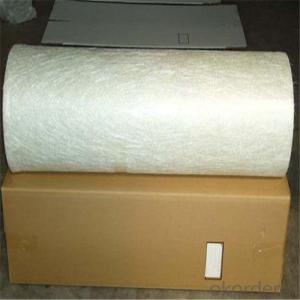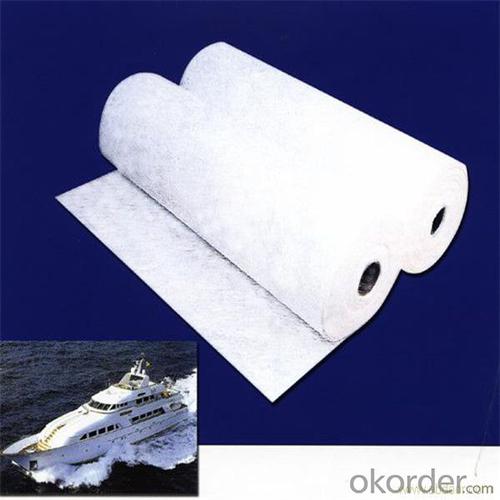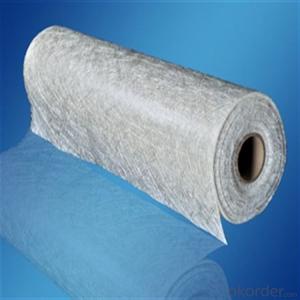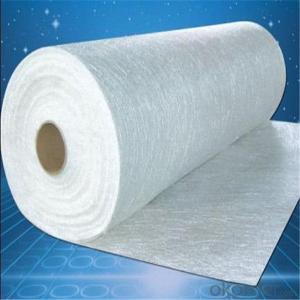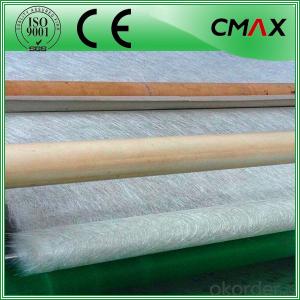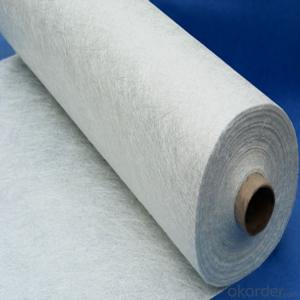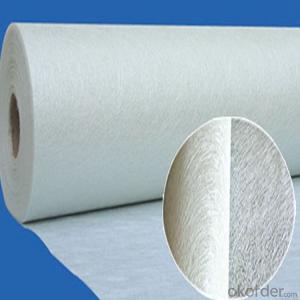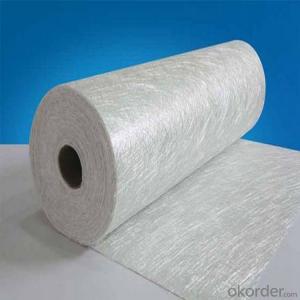Chopped Fiberglass Strands Utah Fiberglass Chopped Sand Mat for Boats
- Loading Port:
- Tianjin
- Payment Terms:
- TT OR LC
- Min Order Qty:
- 100 m.t.
- Supply Capability:
- 20000 m.t./month
OKorder Service Pledge
Quality Product, Order Online Tracking, Timely Delivery
OKorder Financial Service
Credit Rating, Credit Services, Credit Purchasing
You Might Also Like
Quick Details
| Technique: | Chopped Strand Fiberglass Mat (CSM) | Dimensions: | 450gsm | Mat Type: | Continuous Filament Mat |
| Fiberglass Type: | E-Glass | Softness: | softness | Place of Origin: | Jiangxi, China (Mainland) |
| Brand Name: | cnbm | Model Number: | 450gsm | color: | white |
| fiberglass type: | E glass | product: | e-glass powder chopped stand mats | binder: | powder or emulsion |
| width: | 1040 or 1270mm, as your requirement | weight: | 30 or 45kg/roll | paper tube diameter: | 90mm |
| outer diameter of roll: | 256mm | packing: | plastic film+carton box + pallet |
Packaging & Delivery
| Packaging Details: | plastic film+carton box + pallet |
| Delivery Detail: | 15-20days |
Specifications
1.e-glass powder chopped stand mats
2.binder:power or emulsion
3.width:1040mm or 1270mm
4.weight:450gsm
Picture

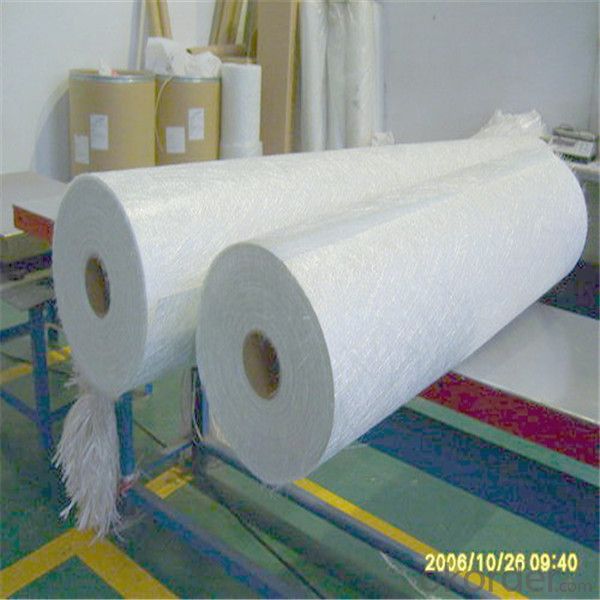




- Q: What is the impact resistance of fiberglass chopped strand?
- Fiberglass chopped strand exhibits a significant level of impact resistance. Renowned for its exceptional strength and durability, fiberglass retains these attributes even when cut into smaller strands. The strands are typically of varying lengths and orientations, effectively dispersing impact forces throughout the material and enhancing its resistance to damage. Consequently, fiberglass chopped strand is widely favored in applications where impact resistance is crucial, such as automotive components, construction materials, and sporting gear. Moreover, utilizing fiberglass chopped strand in composites can further augment the final product's impact resistance. In summary, fiberglass chopped strand is esteemed for its capacity to withstand substantial levels of impact, offering a reliable and long-lasting solution for diverse industries.
- Q: What are the different packaging options for fiberglass chopped strand?
- There are several packaging options available for fiberglass chopped strand, depending on the specific needs and requirements of the customer. 1. Bags: Fiberglass chopped strand can be packaged in bags of various sizes, ranging from small bags of a few kilograms to larger bags of several hundred kilograms. These bags are typically made of durable materials such as plastic or woven polypropylene to ensure the integrity of the product during storage and transportation. 2. Bulk packaging: For customers who require larger quantities of fiberglass chopped strand, bulk packaging options are available. This can include bulk bags or FIBC (Flexible Intermediate Bulk Container) which can hold several tons of chopped strand. This type of packaging is commonly used in industrial applications where large volumes of material are needed. 3. Pallets: Another packaging option for fiberglass chopped strand is pallets. In this case, the chopped strand is packaged in bags or wrapped with protective films and placed on wooden or plastic pallets. This option allows for easy handling, storage, and transportation of the material, particularly for customers who require frequent or regular deliveries. 4. Custom packaging: Depending on the specific requirements of the customer, custom packaging options can be arranged. This can include specialized packaging materials, labeling, or additional protective measures to ensure the quality and safety of the fiberglass chopped strand during transit and storage. Overall, the packaging options for fiberglass chopped strand can vary depending on the quantity, application, and specific needs of the customer. The aim is to provide a secure, convenient, and reliable solution for handling and transporting the product to its intended destination.
- Q: Can fiberglass chopped strand be used in aerospace interior components?
- Yes, fiberglass chopped strand can be used in aerospace interior components. Fiberglass is a lightweight and versatile material that offers excellent strength and durability. It is commonly used in various industries, including aerospace, for its high-performance properties. In aerospace, interior components often require materials that are lightweight yet strong enough to withstand the demanding conditions of flight. Fiberglass chopped strand meets these requirements as it is lightweight and has high tensile strength. It can be used in the manufacturing of interior components such as panels, seat backs, overhead bins, and cabin partitions. Additionally, fiberglass chopped strand offers excellent fire resistance properties, which is crucial for aerospace applications. It can meet the stringent fire safety regulations and requirements set by aviation authorities. Furthermore, fiberglass chopped strand is relatively easy to process, allowing for efficient and cost-effective manufacturing processes. It can be molded into various shapes and sizes, making it suitable for complex aerospace interior designs. Overall, fiberglass chopped strand is a suitable material for aerospace interior components due to its lightweight, high strength, fire resistance, and ease of processing. Its use in the aerospace industry helps to ensure the safety, performance, and comfort of passengers and crew members during flight.
- Q: How to make glass fiber mould
- Glass fiber used for producing glass roving is 12~23 m in diameter. Roving the number from 150 to 9600 (Tex).
- Q: What types of resins can be used with fiberglass chopped strand?
- There are various types of resins that can be used with fiberglass chopped strand, including polyester resin, epoxy resin, and vinyl ester resin. These resins offer different properties and characteristics, allowing for versatility in different applications and desired outcomes.
- Q: Is fiberglass chopped strand suitable for applications requiring high corrosion resistance?
- Fiberglass chopped strand is not suitable for applications that require high corrosion resistance. Despite its many excellent properties, such as high strength-to-weight ratio, dimensional stability, and electrical insulation, fiberglass is not inherently resistant to corrosion. It is a composite material consisting of glass fibers embedded in a resin matrix, which can degrade when exposed to corrosive environments. If you need high corrosion resistance, it is advisable to use materials specifically designed for this purpose, such as stainless steel, aluminum, or corrosion-resistant polymers. These materials offer superior resistance to corrosion and are better suited for applications where protection against chemical or environmental attacks is essential.
- Q: How does the impact resistance of the chopped strand affect its performance?
- The impact resistance of chopped strand directly affects its performance by determining its ability to withstand external forces or impacts without breaking or cracking. A higher impact resistance means that the chopped strand is more durable and less likely to suffer damage from sudden impacts, resulting in improved overall performance and longevity in applications where it is used.
- Q: Can fiberglass chopped strand be used for reinforcing polymer matrix composites?
- Yes, fiberglass chopped strand can be used for reinforcing polymer matrix composites. The chopped strands, made of fine fibers, are added to the polymer matrix to enhance its mechanical properties, such as strength and stiffness. The fibers provide reinforcement and improve the overall performance of the composite material.
- Q: What are the typical manufacturing processes for fiberglass chopped strand composites?
- The manufacturing of fiberglass chopped strand composites involves a series of essential steps. To begin with, the raw materials, which consist of chopped fiberglass strands and a resin matrix, are readied. The chopped fiberglass strands are typically made by cutting continuous glass fibers into shorter lengths, usually ranging from 0.5 to 3 inches. Following this, the resin matrix, typically a thermosetting material like polyester, vinyl ester, or epoxy, is mixed with various additives and catalysts to improve its mechanical properties and curing characteristics. The ratio of resin to chopped fiberglass strands is determined based on the desired strength and performance of the final composite. After the preparation of the raw materials, they are combined through a process known as impregnation. This involves thoroughly coating the chopped fiberglass strands with the resin matrix to ensure saturation. Various techniques, such as hand lay-up, spray-up, or filament winding, can be employed to achieve this. Once impregnation is complete, the composite material is shaped according to the desired form. This can be accomplished using techniques like compression molding, injection molding, or pultrusion. Compression molding requires placing the impregnated material into a mold and applying heat and pressure to shape and cure the resin. Injection molding follows a similar process but entails injecting the resin into a closed mold under high pressure. Pultrusion, on the other hand, continuously pulls the impregnated material through a heated die to shape it into a continuous profile. After shaping, the composite is cured to ensure the hardening of the resin matrix and bonding of the chopped fiberglass strands. Curing can be achieved through heat, chemical reactions, or a combination of both, depending on the specific resin system used. The temperature and duration of curing are precisely controlled to attain the desired mechanical properties and dimensional stability. Lastly, the cured composite undergoes trimming, finishing, and quality inspection. Trimming involves the removal of any excess material or flash that may have formed during shaping and curing. Additional post-processing steps, such as sanding, painting, or coating, may be applied to further enhance the appearance and performance of the finished composite. In summary, the manufacturing processes for fiberglass chopped strand composites involve the preparation of raw materials, impregnation of the chopped fiberglass strands, shaping of the composite, curing of the resin, and finishing of the final product. These processes can be customized based on specific application requirements and desired composite properties.
- Q: How does the fiber content affect the dimensional stability of fiberglass chopped strand composites?
- The fiber content in fiberglass chopped strand composites directly affects the dimensional stability of the material. Dimensional stability refers to the ability of a material to retain its shape and size under different environmental conditions or when subjected to external forces. In the case of fiberglass chopped strand composites, the fiber content plays a crucial role in determining the overall mechanical properties and behavior of the material. Higher fiber content typically results in improved dimensional stability due to the increased reinforcement provided by the fibers. Fiberglass strands are known for their high tensile strength and stiffness, which helps to resist deformation and maintain dimensional stability. When the fiber content is increased, more fibers are distributed throughout the composite matrix, creating a stronger and more rigid structure. This increased strength and stiffness provide better resistance against external forces and minimize dimensional changes. Additionally, the fiber content also affects the matrix-fiber interface. A higher fiber content results in a larger surface area for the matrix to bond with the fibers. This improved bonding enhances the load transfer between the matrix and fibers, further enhancing the dimensional stability of the composite. However, it is important to note that there is an optimal fiber content range for achieving the best dimensional stability. If the fiber content exceeds this range, it can lead to a decrease in matrix resin content, resulting in a higher likelihood of voids and reduced interfacial bonding. This can negatively impact the dimensional stability of the composite, making it more prone to deformation or dimensional changes. In summary, the fiber content in fiberglass chopped strand composites significantly affects the dimensional stability of the material. Increasing the fiber content generally improves the dimensional stability by enhancing the strength, stiffness, and matrix-fiber interface. However, exceeding the optimal fiber content range can have adverse effects on dimensional stability. Proper control and optimization of fiber content are essential to achieve the desired dimensional stability in fiberglass chopped strand composites.
Send your message to us
Chopped Fiberglass Strands Utah Fiberglass Chopped Sand Mat for Boats
- Loading Port:
- Tianjin
- Payment Terms:
- TT OR LC
- Min Order Qty:
- 100 m.t.
- Supply Capability:
- 20000 m.t./month
OKorder Service Pledge
Quality Product, Order Online Tracking, Timely Delivery
OKorder Financial Service
Credit Rating, Credit Services, Credit Purchasing
Similar products
Hot products
Hot Searches
Related keywords
